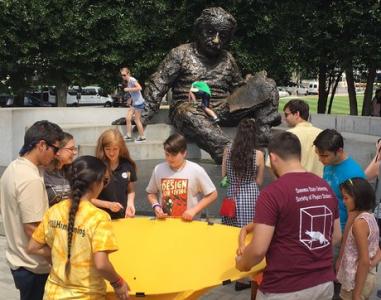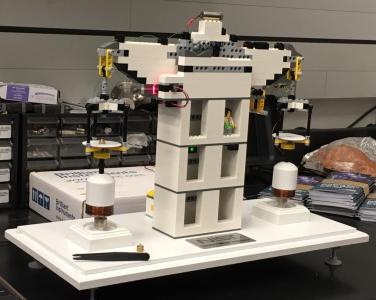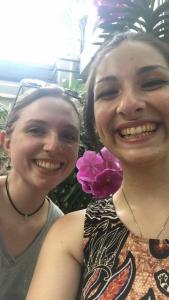Monday, July 25, 2016
By:
Half of us interns got up and going Saturday morning for the Koshland Science Museum's outreach event at the Einstein Memorial (featuring Nobel laureate John Mather). We did a demonstration in which we used spandex stretched over a giant hula hoop as an analog for space time. We would pull down one or two spots to represent massive bodies in space, like the sun. Then the event attendees would roll marbles around to see how smaller mass objects interact with the "gravity" of the more massive bodies. It was a hot morning, but we had a pretty good turn out!

I had a friend from home staying with me for the weekend, so I met back up with her and we went out to lunch with Dahlia and Vanessa. My friend and I went to the United States Botanic Garden, walked around the National Mall, ate some delicious cupcakes and Thai food. We went back to the apartment before going out with Marissa, Dahlia, Vanessa, Tabitha and Tabitha's friend from college. The next day, my friend and I went to brunch with Dahlia before walking around Adams Morgan and Dupont until it was time for her to head home.
My biggest accomplishment in regard to the AIP History project this week was finishing my lesson plan about the conflict between native Hawaiians and the astronomical community over the construction of the Thirty Meter Telescope at Mauna Kea. I was having a tough time picking sources to provide for students to read and learn about the conflict. It is a multifaceted issue with a variety of different viewpoints and I knew I couldn't choose sources without imparting my own bias. As a solution, I decided to start with an activity in which the students read two sources about a similar conflict at Kitt Peak between astronomers and the Apache, and actively identify the biases present in the two documents. Then the students do their own research on the conflict at Mauna Kea while thinking about the specific points of view of their sources. I realized it is futile to try to eliminate the biases in what the students are reading, or even to try to present all points of view equally, and instead teaching students to question the biases in what they read would be more valuable. After all, being able to scrutinize information as it is presented is a vital part of being a successful scientist.
On Wednesday, we had a short work day because we went to an event at the American Astronomical Society (AAS) headquarters. We heard four talks while we were there. The first was from Kevin Marvel, the Executive Officer of the AAS, who told us what the AAS is all about. Next, John Mather told us about his work at NASA's Goddard Space Flight Center on the James Webb Space Telescope. Then we heard from Alycia Weinberger from Carnegie Department of Terrestrial Magnetism (DTM) about stellar and solar system formation. Finally, Heidi Hammel, executive vice president of the Association of Universities for Research in Astronomy (AURA) presented her work on Uranus and Neptune.
On Friday, we all went to the National Institute of Standards and Technology (NIST), where Vanessa and Jose work. In the morning we joined Mariah for the last day of the NIST Summer Institute for Middle School Science Teachers. All of us SPS interns ran a demo fair for the teachers to give them some ideas for fun ways to bring physics into their classrooms. After that, we ate lunch and went on a tour around NIST. We saw the experiment that they’re using to redefine the kilogram, we visited a forensic lab where they’re improving the methods by which people match up bullets and casings to the guns that shot them, and we went to a lab where they’re studying the technology behind battery life and memory in cellphones. That night, I went with Maria and a few of her friends from NASA to an outdoor movie screening of National Treasure: Book of Secrets (an appropriate movie to watch in DC, if you ask me).

Victoria DiTomasso

